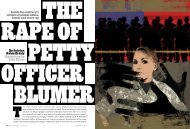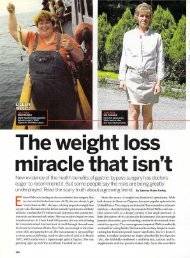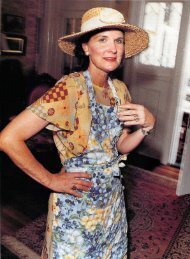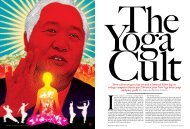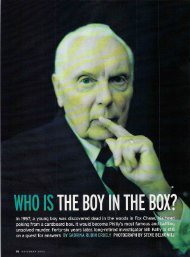School of Hate - Sabrina Rubin Erdely
School of Hate - Sabrina Rubin Erdely
School of Hate - Sabrina Rubin Erdely
Create successful ePaper yourself
Turn your PDF publications into a flip-book with our unique Google optimized e-Paper software.
SCHOOL OF HATE<br />
being addressed. Teachers just didn’t respond.”<br />
In Andover High <strong>School</strong>, when<br />
10th- grader Sam Pinilla was pushed to<br />
the ground by three kids calling him a<br />
“faggot,” he saw a teacher nearby who<br />
did nothing to stop the assault. At Anoka<br />
High <strong>School</strong>, a 10th-grade girl became so<br />
upset at being mocked as a “lesbo” and a<br />
“sinner” – in earshot <strong>of</strong> teachers – that she<br />
complained to an associate principal, who<br />
counseled her to “lay low”; the girl would<br />
later attempt suicide. At Anoka Middle<br />
<strong>School</strong> for the Arts, after Kyle Rooker was<br />
urinated upon from above in a boys’ bathroom<br />
stall, an associate principal told him,<br />
“It was probably water.” Jackson Middle<br />
<strong>School</strong> seventh-grader Dylon Frei was<br />
passed notes saying, “Get out <strong>of</strong> this town,<br />
fag”; when a teacher intercepted one such<br />
note, she simply threw it away.<br />
“You feel horrible about yourself,” remembers<br />
Dylon. “Like, why do these kids<br />
hate me so much? And why won’t anybody<br />
help me?” The following year, after<br />
Dylon was hit in the head with a binder<br />
and called “fag,” the associate principal<br />
told Dylon that since there was no<br />
pro<strong>of</strong> <strong>of</strong> the incident she could take no action.<br />
By contrast, Dylon and others saw<br />
how the same teachers who ignored antigay<br />
insults were quick to reprimand kids<br />
who uttered racial slurs. It further reinforced<br />
the message resonating throughout<br />
the district: Gay kids simply didn’t<br />
deserve protection.<br />
The Lost Boy<br />
“What about my parental rights to have<br />
my gay son go to school and learn without<br />
being bullied?” Tammy Aaberg tearfully<br />
demanded when she confronted the<br />
school board after her son Justin’s death.<br />
tammy aaberg rapped<br />
on her son’s locked bedroom<br />
door again. It was past noon,<br />
and not a peep from inside, unusual<br />
for Justin. ‘Justin?”<br />
“Justin?” She could hear her own voice<br />
rising as she pounded harder, suddenly<br />
overtaken by a wild terror she couldn’t<br />
name. “Justin!” she yelled. Tammy<br />
grabbed a screwdriver and loosened the<br />
doorknob. She pushed open the door.<br />
He was wearing his Anoka High <strong>School</strong><br />
sweatpants and an old soccer shirt. His<br />
feet were dangling <strong>of</strong>f the ground. Justin<br />
was hanging from the frame <strong>of</strong> his<br />
futon, which he’d taken out from under<br />
his mattress and stood upright in the corner<br />
<strong>of</strong> his room. Screaming, Tammy ran<br />
to hold him and recoiled at his cold skin.<br />
His limp body was grotesquely bloated –<br />
her baby – eyes closed, head lolling to the<br />
right, a dried smear <strong>of</strong> saliva trailing from<br />
the corner <strong>of</strong> his mouth. His cheeks were<br />
strafed with scratch marks, as though in<br />
his final moments he’d tried to claw his<br />
noose loose. He’d cinched the woven belt so<br />
tight that the mortician would have a hard<br />
time masking the imprint it left in the flesh<br />
above Justin’s collar.<br />
Still screaming, Tammy ran to call 911.<br />
She didn’t notice the cellphone on the floor<br />
below Justin’s feet, containing his last<br />
words, a text in the wee hours:<br />
:-( he had typed to a girlfriend.<br />
What’s wrong<br />
Nothing<br />
I can come over<br />
No I’m fine<br />
Are you sure you’ll be ok<br />
No it’s ok I’ll be fine, I promise<br />
Seeking relief from bullying,<br />
Brittany transferred to<br />
Jackson Middle <strong>School</strong>. Her<br />
very first day <strong>of</strong> eighth grade,<br />
eight boys crowded around her<br />
on the bus home. “Hey, Brittany, I heard<br />
your friend Sam shot herself,” one began.<br />
“Did you see her blow her brains out?”<br />
“Did you pull the trigger for her?”<br />
“What did it look like?”<br />
“Was there brain all over the wall?”<br />
“You should do it too. You should go<br />
blow your head <strong>of</strong>f.”<br />
Sobbing, Brittany ran from the bus stop<br />
and into her mother’s arms. Her mom<br />
called Jackson’s guidance <strong>of</strong>fice to report<br />
the incident, but as before, nothing ever<br />
seemed to come <strong>of</strong> their complaints. Not<br />
after the Gelderts’ Halloween lawn decorations<br />
were destroyed, and the boys on<br />
ALLEN BRISSON-SMITH/“NEW YORK TIMES”/REDUX<br />
the bus asked, “How was the mess last<br />
night?” Not after Brittany told the associate<br />
principal about the mob <strong>of</strong> kids<br />
who pushed her down the hall and nearly<br />
into a trash can. Her name became<br />
Dyke, Queer, Faggot, Guy, Freak, Transvestite,<br />
Bitch, Cunt, Slut, Whore, Skank,<br />
Prostitute, Hooker. Brittany felt worn to a<br />
nub, exhausted from scanning for threat,<br />
stripped <strong>of</strong> emotional armor. In her journal,<br />
she wrote, “Brittany is dead.”<br />
As Brittany vainly cried out for help,<br />
the school board was busy trying to figure<br />
out how to continue tactfully ignoring<br />
the existence <strong>of</strong> LGBT kids like her. Justin<br />
Aaberg’s suicide, Anoka-Hennepin’s seventh,<br />
had sent the district into damagecontrol<br />
mode. “Everything changed after<br />
Justin,” remembers teacher Fietek. “The<br />
rage at his funeral, students were storming<br />
up to me saying, ‘Why the hell did the<br />
school let this happen? They let it happen<br />
to Sam and they let it happen to Justin!’ ”<br />
Individual teachers quietly began taking<br />
small risks, overstepping the bounds <strong>of</strong><br />
neutrality to <strong>of</strong>fer solace to gay students in<br />
crisis. “My job is just a job; these children<br />
are losing their lives,” says Fietek. “The<br />
story I hear repeatedly is ‘Nobody else is<br />
like me, nobody else is going through what<br />
I’m going through.’ That’s the lie they’ve<br />
been fed, but they’re buying into it based<br />
on the fear we have about open and honest<br />
conversations about sexual orientation.”<br />
LGBT students were stunned to be told<br />
for the first time about the existence <strong>of</strong> the<br />
neutrality policy that had been responsible<br />
for their teachers’ behavior. But no one was<br />
more outraged to hear <strong>of</strong> it than Tammy<br />
Aaberg. Six weeks after her son’s death,<br />
Aaberg became the first to publicly confront<br />
the Anoka-Hennepin school board<br />
about the link between the policy, anti-gay<br />
bullying and suicide. She demanded the<br />
policy be revoked. “What about my parental<br />
rights to have my gay son go to school<br />
and learn without being bullied?” Aaberg<br />
asked, weeping, as the board stared back<br />
impassively from behind a raised dais.<br />
Anti-gay backlash was instant. Minnesota<br />
Family Council president Tom Prichard<br />
blogged that Justin’s suicide could<br />
only be blamed upon one thing: his gayness.<br />
“Youth who embrace homosexuality<br />
are at greater risk [<strong>of</strong> suicide], because<br />
they’ve embraced an unhealthy sexual<br />
identity and lifestyle,” Prichard wrote.<br />
Anoka- Hennepin conservatives formally<br />
organized into the Parents Action League,<br />
declaring opposition to the “radical homosexual”<br />
agenda in schools. Its stated goals,<br />
advertised on its website, included promoting<br />
Day <strong>of</strong> Truth, providing resources for<br />
students “seeking to leave the homosexual<br />
lifestyle,” supporting the neutrality policy<br />
and targeting “pro-gay activist teachers<br />
who fail to abide by district policies.”<br />
Asked on a radio program whether the<br />
anti-gay agenda <strong>of</strong> her ilk bore any responsibility<br />
for the bullying and suicides,<br />
Barb Anderson, co-author <strong>of</strong> the original<br />
“No Homo Promo,” held fast to her principles,<br />
blaming pro-gay groups for the tragedies.<br />
She explained that such “child corruption”<br />
agencies allow “quote-unquote<br />
gay kids” to wrongly feel legitimized. “And<br />
then these kids are locked into a lifestyle<br />
with their choices limited, and many times<br />
this can be disastrous to them as they get<br />
into the behavior which leads to disease<br />
and death,” Anderson said. She added<br />
that if LGBT kids weren’t encouraged to<br />
come out <strong>of</strong> the closet in the first place,<br />
they wouldn’t be in a position to be bullied.<br />
Yet while everyone in the district was<br />
buzzing about the neutrality policy, the<br />
board simply refused to discuss it, not<br />
even when students began appearing before<br />
them to detail their experiences with<br />
LGBT harassment. “The board stated quite<br />
clearly that they were standing behind that<br />
policy and were not willing to take another<br />
look,” recalls board member Wenzel. Further<br />
insulating itself from reality, the district<br />
launched an investigation into the suicides<br />
and unsurprisingly, absolved itself <strong>of</strong><br />
any responsibility. “Based on all the information<br />
we’ve been able to gather,” read a<br />
statement from the superintendent’s <strong>of</strong>fice,<br />
“none <strong>of</strong> the suicides were connected to incidents<br />
<strong>of</strong> bullying or harassment.”<br />
Just to be on the safe side, however, the<br />
district held PowerPoint presentations in<br />
a handful <strong>of</strong> schools to train teachers how<br />
to defend gay students from harassment<br />
while also remaining neutral on homosexuality.<br />
One slide instructed teachers that if<br />
they hear gay slurs – say, the word “fag” –<br />
the best response is a tepid “That language<br />
is unacceptable in this school.” (“If a more<br />
authoritative response is needed,” the slide<br />
added, the teacher could continue with the<br />
stilted, almost apologetic explanation, “In<br />
this school we are required to welcome<br />
all people and to make them feel safe.”)<br />
But teachers were, <strong>of</strong> course, reminded to<br />
never show “personal support for GLBT<br />
people” in the classroom.<br />
Teachers left the training sessions more<br />
confused than ever about how to interpret<br />
the rules. And the board, it turned out, was<br />
equally confused. When a local advocacy<br />
group, Gay Equity Team, met with the<br />
“PEOPLE WERE<br />
DYING,” REMEMBERS<br />
ONE TEEN WHO FELT<br />
SUICIDAL. “EVERY<br />
TIME YOU SAID<br />
GOODBYE TO A FRIEND<br />
YOU FELT LIKE, ‘IS THIS<br />
THE LAST TIME I’M<br />
GOING TO SEE YOU?’ ”<br />
school board, the vice-chair thought the<br />
policy applied only to health classes, while<br />
the chair asserted it applied to all curricula;<br />
and when the district legal counsel<br />
commented that some discussions about<br />
homosexuality were allowed, yet another<br />
board member expressed surprise, saying<br />
he thought any discussion on the topic was<br />
forbidden. “How can the district ever train<br />
on a policy they do not understand themselves?”<br />
GET <strong>of</strong>ficials asked in a follow-up<br />
letter. “Is there any doubt that teachers and<br />
staff are confused? The board is confused!”<br />
With the adults thus distracted by endless<br />
policy discussions, the entire district<br />
became a place <strong>of</strong> dread for students.<br />
Every time a loudspeaker crackled in class,<br />
kids braced themselves for the feared preamble,<br />
“We’ve had a tragic loss.” Students<br />
spoke in hushed tones; some wept openly<br />
in the halls. “It had that feeling <strong>of</strong> a horror<br />
movie – everyone was talking about<br />
death,” says one 16-year-old student who<br />
broke down at Anoka High <strong>School</strong> one day<br />
and was carted <strong>of</strong>f to a psychiatric hospital<br />
for suicidal ideation. Over the course <strong>of</strong> the<br />
2010-2011 school year, 700 students were<br />
evaluated for serious mental-health issues,<br />
including hospitalizations for depression<br />
and suicide attempts. Kids flooded school<br />
counselors’ <strong>of</strong>fices, which reported an explosion<br />
<strong>of</strong> children engaging in dangerous<br />
behaviors like cutting or asphyxiating<br />
each other in the “choking game.”<br />
Amid the pandemonium, the district’s<br />
eighth suicide landed like a bomb: Cole<br />
Wilson, an Anoka High <strong>School</strong> senior with<br />
no apparent LGBT connection. The news<br />
was frightening, but also horrifyingly familiar.<br />
“People were dying one after another,”<br />
remembers former district student<br />
Katie MacDonald, 16, who struggled with<br />
suicidal thoughts. “Every time you said<br />
goodbye to a friend, you felt like, ‘Is this<br />
the last time I’m going to see you?’ ”<br />
As a late-afternoon storm<br />
beats against the windows,<br />
15-year-old Brittany Geldert<br />
sits in her living room. Her<br />
layered auburn hair falls into<br />
her face. Her ears are lined with piercings;<br />
her nail polish is black. “They said I<br />
had anger, depression, suicidal ideation,<br />
anxiety, an eating disorder,” she recites,<br />
speaking <strong>of</strong> the month she spent at a psychiatric<br />
hospital last year, at the end <strong>of</strong><br />
eighth grade. “Mentally being degraded<br />
like that, I translated that to ‘I don’t deserve<br />
to be happy,’ ” she says, barely holding<br />
back tears, as both parents look on<br />
with wet eyes. “Like I deserved the punishment<br />
– I’ve been earning the punishment<br />
I’ve been getting.”<br />
She’s fighting hard to rebuild her decimated<br />
sense <strong>of</strong> self. It’s a far darker self<br />
than before, a guarded, distant teenager<br />
who bears little resemblance to the openhearted<br />
young girl she was not long ago.<br />
But Brittany is also finding [Cont. on 68]<br />
56 | Rolling Stone | rollingstone.com February 16, 2012<br />
February 16, 2012<br />
rollingstone.com | Rolling Stone | 57



